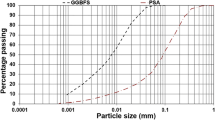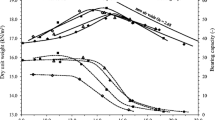Abstract
This paper investigates the use of excavated soil from the Grand Paris Express (GPE) project in blended low-carbon binders. The GPE targets to improve the quality of life of the inhabitants of the Paris metropolitan area by providing better transportation, housing, and job opportunities. However, the quantity of excavated material since the start of the GPE project is around 28 million tons (Mt) and will reach 47 Mt by 2027 (Bilan des émissions de gaz à effet de serre de la Société du Grand Paris et du Grand Paris Express, 2022). Soil samples were taken from 4 sites of the GPE project and analyzed for their physical, chemical, and mineralogical characteristics. Results have evidenced that using flash-calcination (FC) treatment can sensitively enhance material properties. Pozzolanic activity of both raw and treated materials, assessed by Chapelle and Frattini tests showed that flash-calcined excavated soils have a chemical reactivity. Mortars formulated with blended cement produced with the FC materials were mechanically tested and disclosed interesting performances. The evaluation of the environmental impact consisting of leaching tests demonstrated that the treated material can be considered as inert as well as the mortars prepared. These findings indicate soils from the GPE project are suitable for reuse in cementitious matrixes and have the potential to provide economic and environmental benefits.








Similar content being viewed by others
References
Bilan des émissions de gaz à effet de serre de la Société du Grand Paris et du Grand Paris Express (2022)
Heinonen J, Junnila S (2011) Case study on the carbon consumption of two metropolitan cities. Int J Life Cycle Assess 16:569–579. https://doi.org/10.1007/S11367-011-0289-3/TABLES/2
Piao S, Ciais P, Huang Y et al (2010) The impacts of climate change on water resources and agriculture in China. Nature 467:43–51. https://doi.org/10.1038/nature09364
Blengini GA, Garbarino E (2010) Resources and waste management in Turin (Italy): the role of recycled aggregates in the sustainable supply mix. J Clean Prod 18:1021–1030. https://doi.org/10.1016/J.JCLEPRO.2010.01.027
Gangolells M, Casals M, Forcada N, Macarulla M (2014) Analysis of the implementation of effective waste management practices in construction projects and sites. Resour Conserv Recycl 93:99–111. https://doi.org/10.1016/J.RESCONREC.2014.10.006
Eras J, Gutiérrez A, Capote D et al (2013) Improving the environmental performance of an earthwork project using cleaner production strategies. Elsevier, Amsterdam. https://doi.org/10.1016/j.jclepro.2012.11.026
Fabre P, Prévot A-C, Semal L (2016) Le Grand Paris, ville durable? Limites pour la biodiversité urbaine dans un projet de métropolisation emblématique. In: The Greater Paris, a sustainable city? Limits for urban biodiversity in emblematic metropolis plan. Développement durable et territoires. https://doi.org/10.4000/developpementdurable.11131
Ghezloun A, Saidane A, Merabet H (2017) The COP 22 new commitments in support of the Paris Agreement. Energy Procedia 119:10–16. https://doi.org/10.1016/j.egypro.2017.07.040
Blau J (2017) The Paris Agreement. The Paris Agreement: climate change, solidarity, and human rights. pp 1–119. https://doi.org/10.1007/978-3-319-53541-8
Magnusson S, Lundberg K, Svedberg B, Knutsson S (2015) Sustainable management of excavated soil and rock in urban areas—a literature review. J Clean Prod 93:18–25. https://doi.org/10.1016/j.jclepro.2015.01.010
Kenley R, Harfield H (2011) Greening procurement: a research agenda for optimizing mass-haul during linear infrastructure construction
Lenoir T (2019) Reuse of urban soils as earthworks material: geotechnical and environmental specifications. Proceedings 34:3.https://doi.org/10.3390/PROCEEDINGS2019034003
Pramukh GC, Sarangapani G, Prasanna HS (2022) Characteristics of masonry prepared with KM soil as fine aggregate in cement mortar and concrete block. Civil Eng Architect 10:2246–2257. https://doi.org/10.13189/CEA.2022.100603
Yanguatin H, Ramírez JH, Tironi A, Tobón JI (2019) Effect of thermal treatment on pozzolanic activity of excavated waste clays. Constr Build Mater 211:814–823. https://doi.org/10.1016/j.conbuildmat.2019.03.300
Alloul A, Amar M, Benzerzour M, Abriak N (2023) Developing mortar using limestone flash-calcined dredged sediment/millstone-clay cement binder (LFC). J Build Eng 76:107346. https://doi.org/10.1016/j.jobe.2023.107346
Amar M, Benzerzour M, Kleib J, Abriak NE (2021) From dredged sediment to supplementary cementitious material: characterization, treatment, and reuse. Int J Sedim Res 36:92–109
Ramaroson J, Dirion JL, Nzihou A, Depelsenaire G (2009) Characterization and kinetics of surface area reduction during the calcination of dredged sediments. Powder Technol 190:59–64. https://doi.org/10.1016/j.powtec.2008.04.094
Jaskulski R, Jóźwiak-Niedźwiedzka D, Yakymechko Y (2020) Calcined clay as supplementary cementitious material. Materials 13:1–36. https://doi.org/10.3390/ma13214734
Van Bunderen C, Snellings R, Vandewalle L, Cizer Ö (2019) Early-age hydration and autogenous deformation of cement paste containing flash calcined dredging sediments. Constr Build Mater 200:104–115. https://doi.org/10.1016/j.conbuildmat.2018.12.090
AFNOR (2016) NF EN 196-1, Methods of testing cement-Part 1: Determination of strength
Slade RCT, Davies TW, Atakül H et al (1992) Flash calcines of kaolinite: Effect of process variables on physical characteristics. J Mater Sci 27:2490–2500. https://doi.org/10.1007/BF01105062
Teklay A, Yin C, Rosendahl L (2016) Flash calcination of kaolinite rich clay and impact of process conditions on the quality of the calcines: a way to reduce CO2 footprint from cement industry. Appl Energy 162:1218–1224. https://doi.org/10.1016/j.apenergy.2015.04.127
Teklay A, Yin C, Rosendahl L, Køhler LL (2015) Experimental and modeling study of flash calcination of kaolinite rich clay particles in a gas suspension calciner. Appl Clay Sci 103:10–19. https://doi.org/10.1016/j.clay.2014.11.003
San Nicolas R, Cyr M, Escadeillas G (2013) Characteristics and applications of flash metakaolins. Appl Clay Sci 83–84:253–262. https://doi.org/10.1016/j.clay.2013.08.036
Nicolas S (2012) Approche performantielle des bétons avec métakaolins obtenus par calcination flash
AFNOR (2008) NF EN 1097-7—Tests for mechanical and physical properties of aggregates—Part 7: determination of the particle density of filler—Pyknometer method
AFNOR (2006) NF EN ISO 18757, Determination of specific surface aea of ceramic powders by gas adsorption using the BET method
AFNOR (2012) NF P 18-513-Additions pour béton hydraulique- Métakaolin
Chu DC, Amar M, Kleib J et al (2022) The Pozzolanic activity of sediments treated by the flash calcination method. Waste Biomass Valor 13:4963–4982. https://doi.org/10.1007/s12649-022-01789-8
Amar M, Benzerzour M, Abriak NE (2022) Designing efficient flash-calcined sediment-based ecobinders. Materials (Basel) 15:7107–7107. https://doi.org/10.3390/MA15207107
Tashimo T, Murota J, Suto T, Kato K (2000) Physical properties of lime powder produced by powder-particle fluidized bed. J Chem Eng Jpn 33:365–371. https://doi.org/10.1252/JCEJ.33.365
Day RL, Shi C (1994) Influence of the fineness of pozzolan on the strength of lime-natural pozzolan cement pastes. Cem Concr Res 24:1485–1491
Vizcaíno Andrés LM, Antoni MG, Alujas Diaz A et al (2015) Effect of fineness in clinker-calcined clays-limestone cements. Adv Cem Res 27:546–556. https://doi.org/10.1680/JADCR.14.00095
Fernandez R, Martirena F, Scrivener KL (2011) The origin of the pozzolanic activity of calcined clay minerals: a comparison between kaolinite, illite and montmorillonite. Cem Concr Res 41:113–122. https://doi.org/10.1016/j.cemconres.2010.09.013
Danner T, Norden G, Justnes H (2018) Characterisation of calcined raw clays suitable as supplementary cementitious materials. Appl Clay Sci 162:391–402. https://doi.org/10.1016/j.clay.2018.06.030
Menadi B, Kenai S, Khatib J, Aït-Mokhtar A (2009) Strength and durability of concrete incorporating crushed limestone sand. Constr Build Mater 23:625–633. https://doi.org/10.1016/j.conbuildmat.2008.02.005
Ferraz E, Andrejkovičová S, Hajjaji W et al (2015) Pozzolanic activity of metakaolins by the French standard of the modified Chapelle test: a direct methodology. Acta Geodyn Geomater 12:289–298. https://doi.org/10.13168/AGG.2015.0026
Liu Y, Huang Q, Zhao L, Lei S (2021) Influence of kaolinite crystallinity and calcination conditions on the pozzolanic activity of metakaolin. Gospod Surowcami Miner/Miner Resour Manag 37:39–56. https://doi.org/10.24425/GSM.2021.136295
Yudenfreund M, Hanna KM, Skalny J et al (1972) Hardened Portland cement pastes of low porosity V.Compressive strength. Cem Concr Res 2:731–743. https://doi.org/10.1016/0008-8846(72)90008-7
Author information
Authors and Affiliations
Corresponding author
Additional information
Publisher's Note
Springer Nature remains neutral with regard to jurisdictional claims in published maps and institutional affiliations.
Rights and permissions
Springer Nature or its licensor (e.g. a society or other partner) holds exclusive rights to this article under a publishing agreement with the author(s) or other rightsholder(s); author self-archiving of the accepted manuscript version of this article is solely governed by the terms of such publishing agreement and applicable law.
About this article
Cite this article
Amar, M., Kleib, J., Tall, M. et al. Case study: reuse of excavated soils from the Grand Paris Express project for the formulation of low-carbon cementitious matrixes : Part 1. J Mater Cycles Waste Manag (2024). https://doi.org/10.1007/s10163-024-01957-z
Received:
Accepted:
Published:
DOI: https://doi.org/10.1007/s10163-024-01957-z




